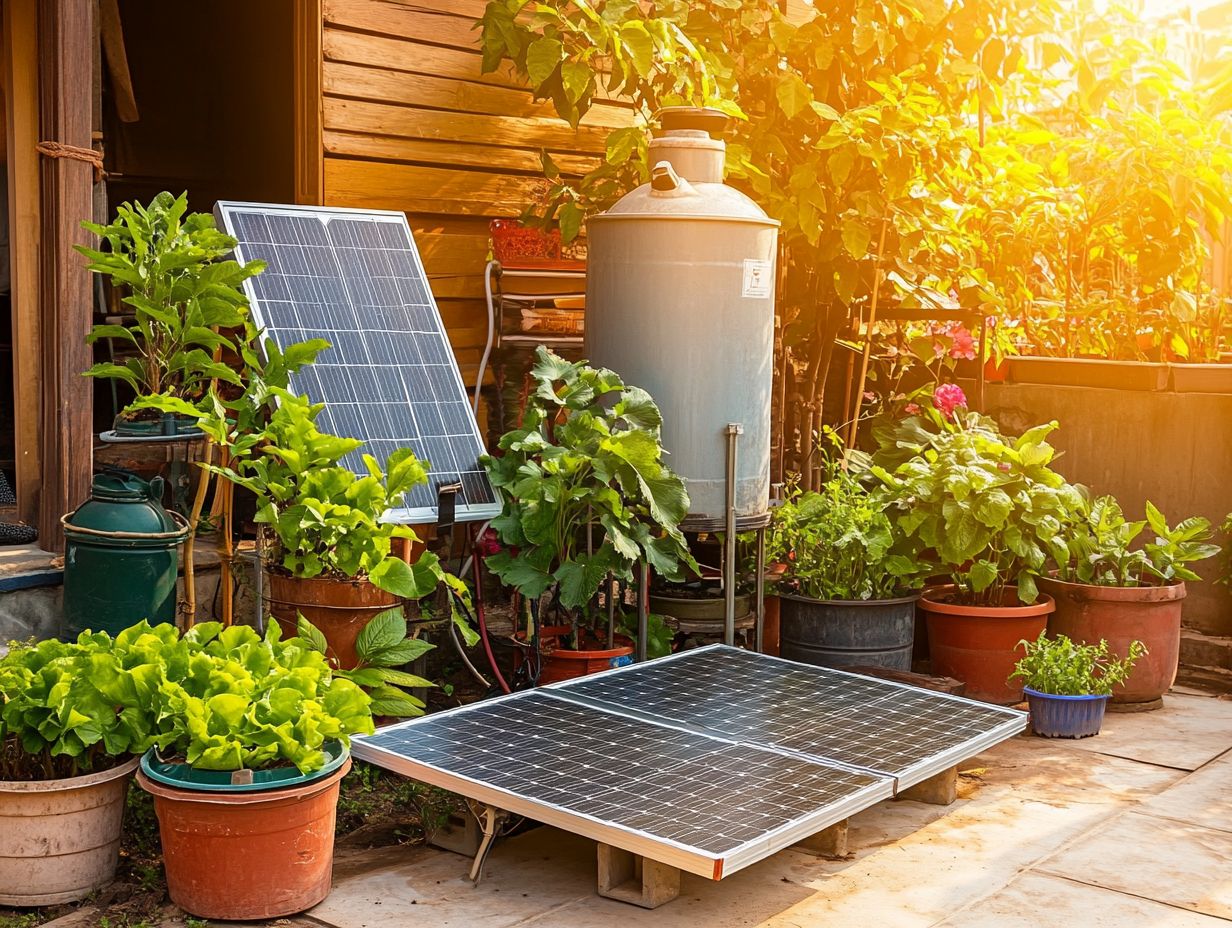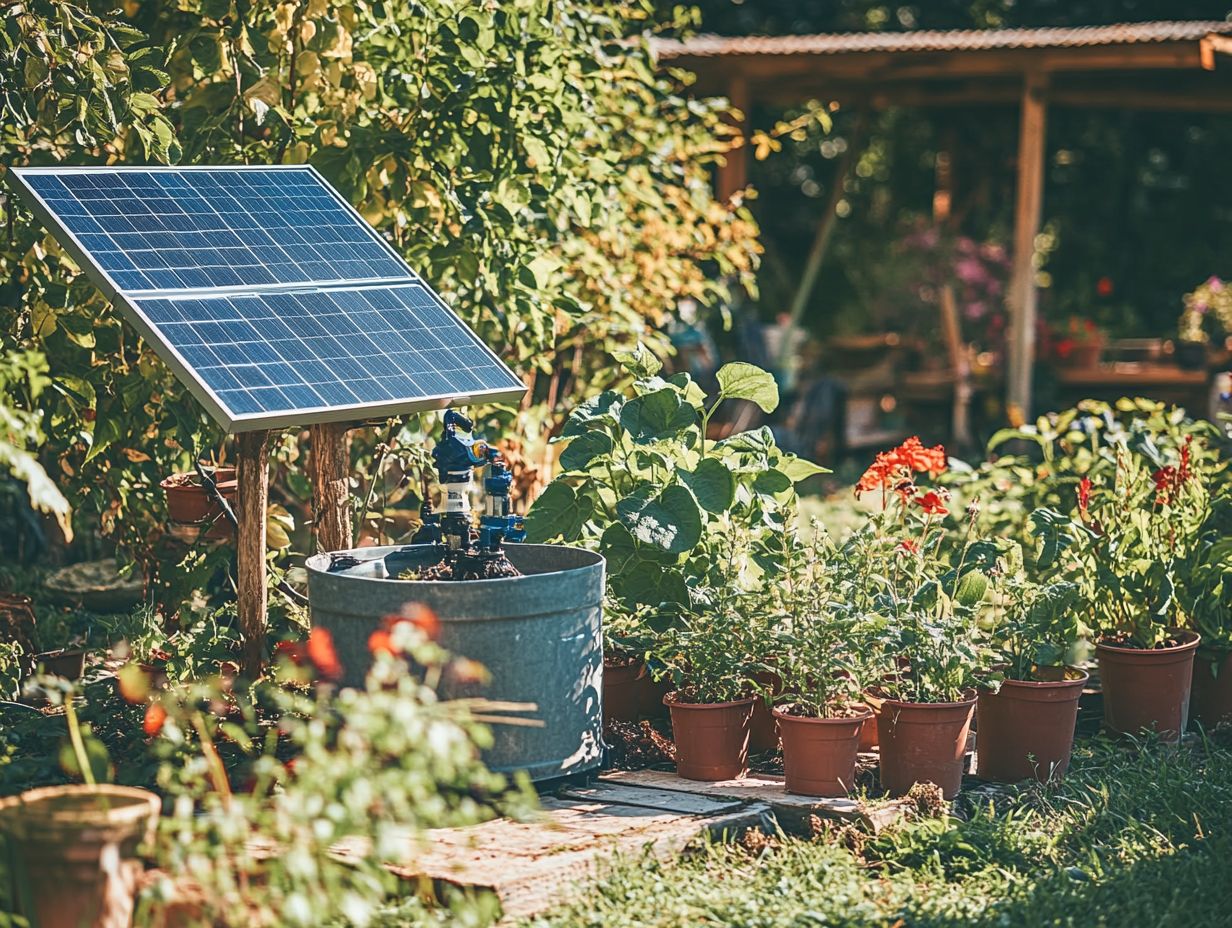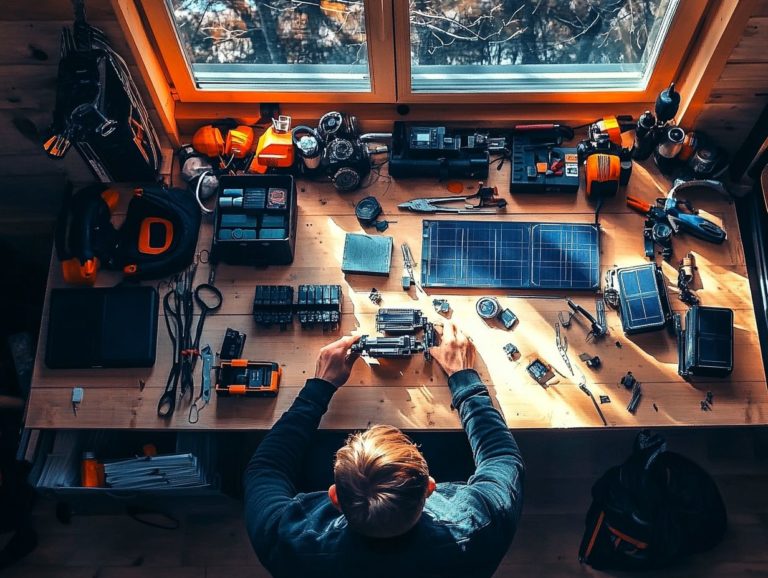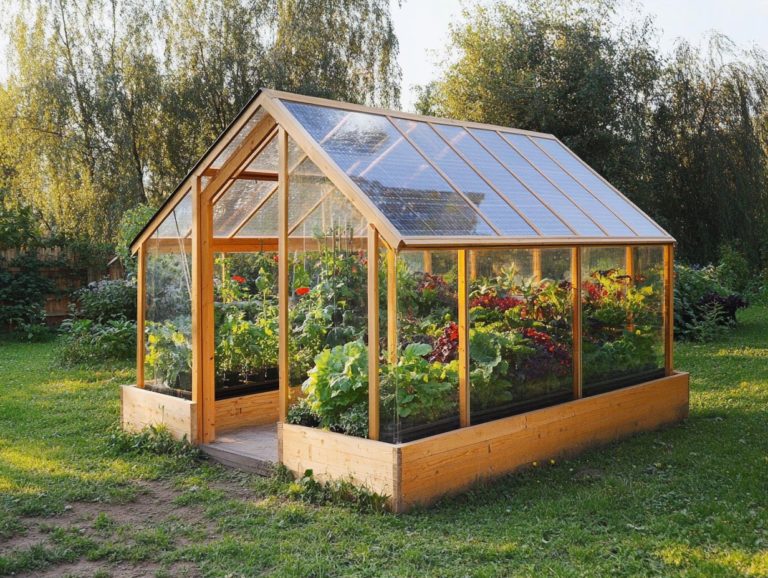How to Make Your Own Solar Water Pump
If you ve ever thought about using solar energy for sustainable water solutions, a solar water pump or solar-powered water pump could be exactly what you re looking for.
These systems are eco-friendly and cost-effective, providing a practical means to access water for irrigation, livestock, or household needs.
This article delves into the benefits of solar water pumps, explores the various types available, and offers a detailed guide on how to build your own. You ll also find essential maintenance tips to ensure your pump operates smoothly for years.
It s easy to create your own solar-powered oasis!
- Key Takeaways:
- Benefits of Using a Solar Water Pump
- Discover Your Options: Surface vs. Submersible Pumps
- Materials and Tools Needed for DIY Solar Water Pump
- Step-by-Step Guide to Building Your Own Solar Water Pump
- Detailed Instructions and Tips
- Maintenance and Troubleshooting
- Frequently Asked Questions
- What materials do I need to make my own solar water pump?
- Is it difficult to assemble a solar water pump?
- Do I need any special skills to make a solar water pump?
- How much will it cost me to make my own solar water pump?
- What are the benefits of using a solar water pump?
- Can I use my solar water pump during cloudy days?
- Build your own solar water pump as an eco-friendly and cost-effective alternative to traditional water pumps.
- Choose between surface or submersible pumps. Gather the necessary materials and tools, like a multimeter, screwdriver, and pliers, to start your DIY project.
- Follow our step-by-step guide and maintenance tips to keep your solar water pump running smoothly, providing a sustainable and reliable source of water.
Contents
Key Takeaways:

What is a Solar Water Pump?
A solar water pump is an eco-friendly and efficient device that moves water using renewable energy harnessed from solar panels. This makes it a great choice for various applications, including irrigation systems, fountains, and household needs. Unlike traditional electric pumps, solar-powered water pumps operate independently of grid electricity, relying instead on a battery charged by solar energy. This promotes sustainability and reduces your carbon footprint.
These systems typically comprise several key components, such as mini DC water pumps that draw water efficiently while consuming minimal energy. Solar panels capture sunlight and convert it into electricity to power the system. Charge controllers manage the energy flow to the batteries, preventing overcharging and maintaining optimal performance.
The versatility of solar water pumps allows you to use them in various settings, including:
- Agricultural settings for crop irrigation
- Residential areas for garden water features
- Livestock watering
By utilizing renewable energy, these pumps not only reduce dependence on fossil fuels but also substantially lower operating costs. This makes them a savvy investment for anyone aiming to boost energy efficiency and contribute to a more sustainable environment.
Benefits of Using a Solar Water Pump
Whether you’re gardening or engaging in outdoor activities, a solar-powered water pump offers numerous benefits that enhance energy efficiency while minimizing environmental impact. This choice is particularly advantageous for homeowners, gardeners, and farmers.
By integrating renewable energy into these systems, you reduce reliance on fossil fuels and significantly lower the carbon footprint typically associated with traditional water pumps. It’s not just a smart decision; it s a step toward a more sustainable future.
Eco-Friendly and Cost-Effective
Solar water pumps stand out as an eco-friendly and cost-effective solution for your various water needs, all while minimizing environmental impact. By harnessing renewable energy from solar panels, along with a device that regulates energy and battery system, you can significantly cut down on operational costs and lessen your dependence on non-renewable energy sources.
This approach not only translates to substantial savings on your electricity bills but also reduces ongoing maintenance expenses. Solar water pumps typically require fewer mechanical components than traditional systems.
Embracing the sun’s energy reflects a strong commitment to sustainability, offering you a reliable alternative that actively contributes to the reduction of greenhouse gas emissions.
As communities increasingly seek greener solutions, solar water pumps present themselves as a wise investment, merging effective water management with environmental responsibility. Their long-term benefits make them an appealing choice for homeowners, farmers, and businesses alike, enhancing both financial and ecological well-being.
Discover Your Options: Surface vs. Submersible Pumps

You will find that there are primarily two types of solar water pumps: surface pumps, adept at drawing water from shallow sources, and submersible pumps, crafted for deeper water extraction. Each type serves distinct applications, whether for irrigation, household needs, or even aquaculture.
By grasping the differences between these pumps, you can make an informed choice that perfectly aligns with your specific water pumping requirements.
Surface Pumps vs. Submersible Pumps
Surface pumps and submersible pumps each possess distinct characteristics that make them ideal for various applications in solar water pumping. You ll find that surface pumps are typically best suited for shallow water sources, offering ease of maintenance, while underwater pumps shine in deeper wells, delivering superior performance when it comes to pushing water to the surface.
Regarding flow rates, surface pumps usually output lower volumes compared to their underwater counterparts. The latter excels in high-pressure situations (like needing to push water from a deep well) and can effectively operate at greater water depths.
In terms of installation, surface models are generally simpler to set up, requiring minimal effort, whereas underwater pumps demand careful handling and precise placement beneath the water’s surface.
Understanding these technical distinctions is crucial for you to determine which pump type aligns with your specific needs. It s important to consider efficiency, cost-effectiveness, and the unique conditions of your water source. Surface pumps are often the go-to choice for watering smaller gardens, while underwater pumps are invaluable in agricultural scenarios that rely on deep groundwater extraction.
Materials and Tools Needed for DIY Solar Water Pump
To successfully create your own solar water pump, you will require specific materials and tools, including a solar panel, battery, pump motor, device that regulates energy, and essential hand tools like a screwdriver and pliers.
Basic tools like a multimeter for measuring voltage and current are also handy. This hands-on DIY project not only gives you the power to take charge of your water needs but also aligns with your commitment to sustainability.
By organizing a comprehensive list of components, you can streamline the assembly process and ensure that everything you need is readily available, paving the way for a seamless and rewarding construction experience.
Gather these materials today and begin your exciting journey to harness solar energy!
List of Required Supplies
Gather essential supplies for your DIY solar water pump project. You will need a solar panel, a battery, a pump motor, and a charge controller.
Choose a solar panel with an 18V rating and at least 5A current output. This ensures your pump operates smoothly.
Your battery should be 12V with a capacity of 20Ah. This allows it to store enough energy for nighttime use, keeping the water flow uninterrupted.
For the pump motor, select one that runs on 12V and requires at least 3A. This setup maximizes performance and energy efficiency.
A charge controller rated at 10A is crucial to prevent overcharging and extend your battery s lifespan.
By choosing and integrating these components wisely, you can enhance the efficiency and reliability of your solar water pump, and you might also explore how to make your own solar oven for additional sustainable energy solutions.
Step-by-Step Guide to Building Your Own Solar Water Pump

Building your own solar water pump is an exciting DIY adventure. This guide will give you detailed assembly instructions to create a fully functional device powered by solar energy.
With the right tools, like a multimeter for testing connections, and some basic assembly skills, you can easily follow this guide to make a homemade heat pump to build a sustainable water pumping solution.
Detailed Instructions and Tips
The detailed instructions for assembling your solar water pump will guide you through the essential steps of connecting the solar panel to the charge controller, attaching the battery for energy storage, and finally linking the pump motor to ensure optimal performance. Following these guidelines will help you avoid any installation hiccups and guarantee a successful DIY project.
To begin, choose the best spot for your solar panel to grab every ray of sunshine! This strategic placement maximizes the energy harnessed and boosts the pump’s efficiency. For a comprehensive approach, check out how to build your own solar water heater, where you’ll also find testing and troubleshooting tips to fine-tune your setup.
When attaching the charge controller, pay close attention to the positive and negative terminals connecting them incorrectly means connecting the wires the wrong way, which could potentially damage your system. Opt for high-quality connectors and waterproof seals to enhance durability and longevity.
As you connect the pump motor, always inspect for leaks and ensure it is securely mounted. This vigilance will prevent vibrations that might lead to malfunctions over time.
If you encounter issues like insufficient power output or erratic pump performance, double-check all connections and assess the battery voltage and current for effective troubleshooting.
This DIY project requires close attention to detail and the use of basic tools like a multimeter (a tool for measuring electrical properties), screwdriver, and pliers for testing and troubleshooting.
Maintenance and Troubleshooting
Proper maintenance and troubleshooting are crucial for ensuring your solar water pump operates smoothly and efficiently. Every component from the solar panel to the battery and pump motor must function optimally.
Regularly inspecting connections and monitoring performance metrics can prevent unexpected downtime and enhance the longevity of your system. This diligence maximizes operational benefits, amplifying the positive environmental impact and helping reduce the carbon footprint of your solar setup.
How to Keep Your Solar Water Pump Running Smoothly
To keep your solar water pump operating at its best, prioritize regular maintenance. This includes checking all connections, inspecting the solar panel for any debris, and testing the pump motor’s performance. By adhering to these practices, you can ensure long-lasting efficiency and reliability in your water pumping system.
Don’t forget these essential checks! Seasonal maintenance routines are vital. During spring and fall, clean filters and inspect hoses to prevent future obstructions and clogs, saving you from headaches down the line.
To troubleshoot common performance issues, start by monitoring flow rates and pressure. If you notice any fluctuations in these metrics, it could signal blockages or pressure drops that need your immediate attention.
By remaining proactive about maintenance and conducting routine inspections, you can identify potential problems early on. This approach ensures that your solar water pump continues to operate at peak efficiency and fulfills its purpose effectively. Such diligent practices will benefit your renewable energy setup, ensuring it remains eco-friendly and cost-effective.
Start your maintenance routine today for optimal performance!
Frequently Asked Questions

What materials do I need to make my own solar water pump?
To make your own solar water pump, you will need a solar panel, mini DC water pump, battery, pipes, and fittings. You may also need a charge controller and wiring for the solar panel. A detailed components list is essential for gathering all necessary parts for your DIY project.
Is it difficult to assemble a solar water pump?
No, assembling a solar water pump is not difficult. As long as you have all the necessary materials and follow the step-by-step assembly instructions carefully, you should be able to assemble it easily.
Do I need any special skills to make a solar water pump?
No, you do not need any special skills to make a solar water pump. Basic knowledge of electrical wiring and plumbing can be helpful, but it is not necessary. Using basic tools like a multimeter, screwdriver, and pliers can facilitate the assembly and installation process.
How much will it cost me to make my own solar water pump?
The cost of making your own solar water pump will vary depending on the materials you use and where you purchase them. However, it is generally more cost-effective than buying a pre-made pump. Additionally, the long-term savings on electricity make it a sustainable choice.
What are the benefits of using a solar water pump?
Using a solar water pump has many benefits, including reducing your carbon footprint, saving on electricity costs, and being more environmentally friendly. It also allows for easy water access in remote areas without electricity. Additionally, it is highly versatile with uses in irrigation systems, gardening, and even fountains or fish tanks.
Can I use my solar water pump during cloudy days?
Yes, you can still use your solar water pump during cloudy days. The solar panel will still generate some electricity, but the pump may not be as efficient as it would be on a sunny day. Ensure your battery and charge controller are properly connected to optimize performance under varying weather conditions.






